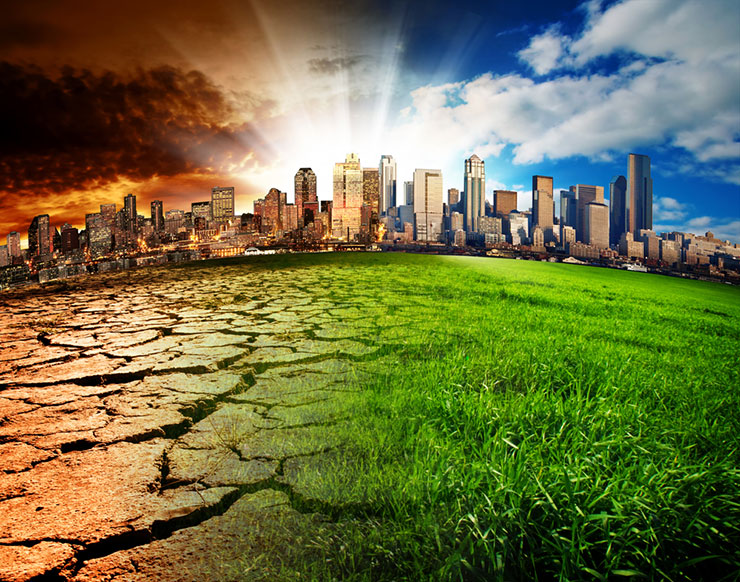Which Of These Would Be An Example Of Mitigation Rather Than Adaptation For Global Climate Change?
NASA is a world leader in climate studies and Earth scientific discipline. While its role is not to set climate policy or prescribe detail responses or solutions to climate modify, its purview does include providing the robust scientific information needed to sympathize climate alter. NASA then makes this information bachelor to the global community – the public, policy- and conclusion-makers and scientific and planning agencies around the earth.

Climate change is one of the nigh complex issues facing us today. It involves many dimensions – scientific discipline, economics, club, politics and moral and upstanding questions – and is a global trouble, felt on local scales, that will be around for decades and centuries to come up. Carbon dioxide, the heat-trapping greenhouse gas that has driven recent global warming, lingers in the atmosphere for hundreds of years, and the planet (especially the oceans) takes a while to reply to warming. So even if we stopped emitting all greenhouse gases today, global warming and climate alter volition continue to affect future generations. In this fashion, humanity is "committed" to some level of climate alter.
How much climatic change? That volition be determined by how our emissions keep and exactly how our climate system responds to those emissions. Despite increasing sensation of climatic change, our emissions of greenhouse gases continue on a relentless rise. In 2013, the daily level of carbon dioxide in the temper surpassed 400 parts per million for the commencement time in human history. The last time levels were that loftier was about 3 to five million years ago, during the Pliocene Epoch.
Because nosotros are already committed to some level of climatic change, responding to climate change involves a two-pronged approach:
- Reducing emissions of and stabilizing the levels of heat-trapping greenhouse gases in the atmosphere ("mitigation");
- Adapting to the climate change already in the pipeline ("accommodation").
Mitigation and Adaptation

Mitigation – reducing climate change – involves reducing the menstruum of oestrus-trapping greenhouse gases into the atmosphere, either by reducing sources of these gases (for case, the burning of fossil fuels for electricity, estrus or transport) or enhancing the "sinks" that accumulate and store these gases (such every bit the oceans, forests and soil). The goal of mitigation is to avert significant human interference with the climate system, and "stabilize greenhouse gas levels in a timeframe sufficient to allow ecosystems to accommodate naturally to climate change, ensure that food production is not threatened and to enable economical evolution to proceed in a sustainable manner" (from the 2014 written report on Mitigation of Climatic change from the United nations Intergovernmental Console on Climatic change, page 4).
Adaptation – adapting to life in a changing climate – involves adjusting to bodily or expected future climate. The goal is to reduce our vulnerability to the harmful effects of climate alter (like sea-level encroachment, more intense extreme weather condition events or food insecurity). It too encompasses making the most of any potential beneficial opportunities associated with climate change (for example, longer growing seasons or increased yields in some regions).
Throughout history, people and societies have adjusted to and coped with changes in climate and extremes with varying degrees of success. Climate change (drought in particular) has been at least partly responsible for the rise and fall of civilizations. Earth'southward climate has been relatively stable for the past 12,000 years and this stability has been crucial for the development of our mod civilization and life as we know information technology. Modern life is tailored to the stable climate nosotros have get accustomed to. Equally our climate changes, we will have to learn to adapt. The faster the climate changes, the harder it could be.
While climate change is a global effect, it is felt on a local scale. Cities and municipalities are therefore at the frontline of adaptation. In the absence of national or international climate policy direction, cities and local communities around the world have been focusing on solving their ain climate problems. They are working to build inundation defenses, plan for heatwaves and higher temperatures, install water-permeable pavements to better bargain with floods and stormwater and ameliorate h2o storage and use.
According to the 2014 report on Climate change Impacts, Adaptation and Vulnerability (page 8) from the United nations Intergovernmental Panel on Climate Change, governments at various levels are also getting better at adaptation. Climate change is starting to be factored into a variety of development plans: how to manage the increasingly extreme disasters nosotros are seeing and their associated risks, how to protect coastlines and deal with sea-level encroachment, how to best manage country and forests, how to deal with and plan for reduced water availability, how to develop resilient crop varieties and how to protect energy and public infrastructure.
How NASA is Involved

NASA, with its Optics on the Earth and wealth of knowledge on the Earth's climate system and its components, is one of the world's experts in climate science. NASA's purview is to provide the robust scientific data needed to empathize climate alter. For example, information from the agency's Gravity Recovery and Climate Experiment (GRACE) and Ice, Cloud and land Elevation Satellite (ICESat) missions and from radar instruments in space have shown rapid changes in the Earth's great ice sheets. The Jason-three, Jason-2/OSTM Surface Topography Mission (OSTM) and Jason-1 missions have documented an increasing sea level since 1992.
NASA makes detailed climate data bachelor to the global community – the public, policy- and decision-makers and scientific and planning agencies around the world. It is not NASA'south office to set climate policy or prescribe particular responses or solutions to climate change. NASA is i of 13 U.S. government agencies that form office of the U.Southward. Global Change Research Program, which has a legal mandate to help the nation and the earth sympathize, assess, predict and respond to global change. These U.Due south. partner agencies include the Department of Agriculture, the Ecology Protection Agency and the Section of Free energy, each of which has a different purview depending on their area of expertise.
Started in 2010, NASA's Carbon Monitoring Arrangement (CMS) is a forwards-looking initiative established under management past the U.S. government. The CMS is improving the monitoring of global carbon stocks (where carbon is stored effectually the planet) and fluxes (how carbon is cycled from one stock to the next). The ultimate goal is to make breakthroughs in quantifying, agreement and predicting how worldwide carbon sources and sinks are changing, since this could accept major ramifications for how our planet will respond to increasing emissions and/or efforts to combat climatic change. The work will too help inform virtually-term policy development and planning.
NASA's related Megacities Carbon Project is focused on the problem of accurately measuring and monitoring greenhouse-gas emissions from the globe's biggest cities. About 3-quarters of fossil-fuel carbon dioxide emissions come up from about 2 percent of the land surface – the cities and the power plants that feed them. Now the focus is on pilot projects in Los Angeles and Paris that sample the air at that place. The goal is to add other cities around the world and to ultimately deploy a worldwide urban carbon monitoring system that will enable local policymakers to fully account for the many sources and sinks of carbon and how they change over fourth dimension.
Although NASA's main focus is not on energy-technology research and evolution, work is being done around the agency and by/with various partners and collaborators to notice viable alternative sources of energy to power our needs. These sources of energy include the wind, waves, the Sun and biofuels.
Related Articles
For farther reading on NASA's work on mitigation and adaptation, take a look at the manufactures listed below.
- NASA test: Jet biofuel may reduce climate-warming clouds
- Targeting megacity carbon emissions
- Cleaning the air would limit short-term climate warming
- Building a amend soybean for a hot, dry, hungry world
- Simply 5 questions: Hacking the planet
- Nuking the sky
- Climate change and the ascent and fall of civilizations
- Just 5 questions: Customs initiatives against climate change
- U.S. Navy bracing for climate change
- A tale of ii cities
Source: https://climate.nasa.gov/solutions/adaptation-mitigation/
Posted by: chavezhond1975.blogspot.com


0 Response to "Which Of These Would Be An Example Of Mitigation Rather Than Adaptation For Global Climate Change?"
Post a Comment